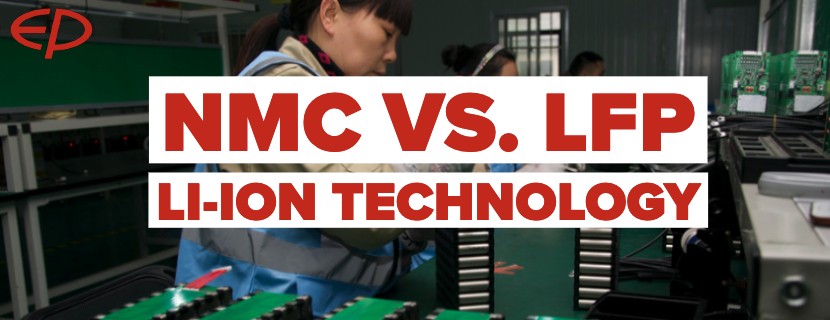
Not all Lithium Batteries Are Created Equal: Sealed, Safe & Socially Responsible
Advances in battery technology and the electrification of the material handling market has contributed enormously to the changing industry landscape. It’s pretty obvious that highly corrosive, hazardous lead- acid batteries have backed out of the electrification race but discussions around the safety and geopolitics of lithium-ion batteries have propagated speculation. But – not all lithium batteries are created equal because there are significantly types that should not be confused.
Within the lithium family of batteries there are numerous types of chemistries, variations of nodes, cathodes, storage configurations and manufacturing methods. The main two being Lithium Nickel Manganese Cobalt Oxide Batteries & Lithium Iron Phosphate Battery which offer two completely different sub-chemistries.
Lithium Nickel Manganese Cobalt Oxide Batteries (NMC) offers a combination of Nickel, Manganese and Cobalt. There are many reasons manufacturers use NMC Batteries, especially due to their high energy density, this allows powered equipment to be more compact and light. Due to the cell chemistry, NMC types rarely ignite, but it is possible when punctured (ep-ep.com/ ). The NMC cell is more likely to get into an unstable state than LFP alternatives . Well known in the car industry, NMC technology is still regarded as reasonably safe, in most cases, the battery is protected by durable steel components & precautionary safety features are designed to significant lessen the chance of chemical instability.
Fundamentally, the primary danger occurs when the NMC battery becomes damaged, this includes being exposed to extreme heat or something that penetrates the battery cell wall. Excessive heat or penetration of the battery can cause an internal short circuit, the heat cannot disappear as fast as it’s generated which causes a chemical reaction called, ‘thermal runway’ which can lead to ignition. The integration of NMC Batteries in electric vehicles is seeing exponential growth and safety features are being put in place to eliminate the chance of ‘thermal runway’. This includes the integration of battery management systems (BMS) which can monitor its state, control the environment & prevent overcharging. Elon Musk commented on the subject, “Tesla, like more electric cars, are 500% less likely to catch fire than engine cars, which carry massive amounts of highly flammable fuels ” (airqualitynews,2020).
The primary concern with NMC batteries is the mining of cobalt, which has caused geo- strategic rivalry between the world’s largest economies. The environmental impact of cobalt in lithium-ion batteries through the life-cycle of the product from refineries, battery plants, consumer goods manufacturing, recycling and landfills (theguardian,2019).
Compared to fossil fuels, NMC batteries are a pivotal piece in the transition to clean energy. They have fantastic power density with a long lifecycle, these qualities are extremely important as NMC batteries can be powered by renewable energy power sources. Numerous scientific studies have proven that NMC lithium-ion batteries are s ignificantly more sustainable than the internal combustion engine. NMC lithium powered Electric vehicles do not produce any emissions when running, the only damaging process is the initial metal extraction.
Lithium Iron Phosphate batteries or LFP is known as a more stable chemistry, the broad temperature variation is wider than most other battery chemical compositions making LFP technology the safest option for internal vehicles. As the temperature threshold is much higher than that of NCM battery, this means the risk of electric shortages or possibly fire is almost entirely eradicated. Some of the key benefits of LFP technology are the high current rating and longer cycle life enhancing the safety and tolerance if battery is abused. LFP is more tolerant to full charge conditions and remains less stressed than other lithium-ion batteries (betterworldsolutions,2020). If
kept at high voltage for a prolonged time, LFP technology can easily cope due to its high thermal stability. The higher the thermal stability, the less risk of fire or dangerous chemical reaction.
Known for consistency, reliability and longer lifespan, LFP batteries are the obvious choice for countless different situations and equipment. LFP batteries are much safer, they avoid reactivity and sensitivity issues involved with the use of lithium metal cathodes by using phosphate (Acumentrics Whitepaper). LFP batteries are the safest all round from extraction to usage. From a humanitarian point of view, LFP batteries pose less environmental and health risks. While cobalt & nickel are described as the green energy necessity, they have grave risks. Removing cobalt and nickel from the chemistry of an LFP battery has eliminated the need for an additional extraction process. Taking away a number of environmentally damaging burdens that are imposed on society, reducing cobalt chemical exposure, water pollution, worker exploitation, occupational exposure, air pollutants and cobalt mining accidents.
The shift to a circular low-carbon economy is likely to lead to numerous important changes in the supply and demand of materials. There is no doubt that, lithium-ion batteries are a crucial component in the aid to clean up the planet. After evaluating pro’s and cons of both batteries, we have decided that our priority is safety for both direct users and those involved in the cobalt and nickel extraction process. Therefore, EP Equipment & Forktruck Solutions now produces all its lithium forklift trucks with LFP batteries – to protect your business, protect you & the planet.
If your interested in switching you forklift truck fleet to affordable Lithium contact Forktruck Solutions.
0845 555 7770
info@forktrucksolutions

